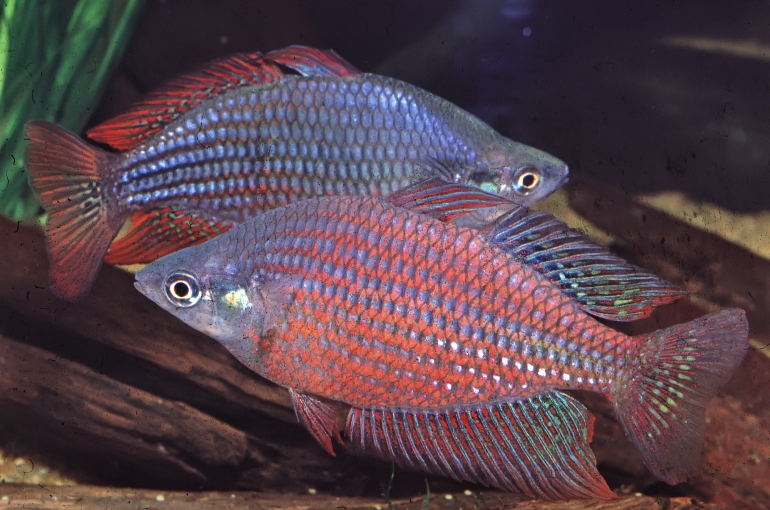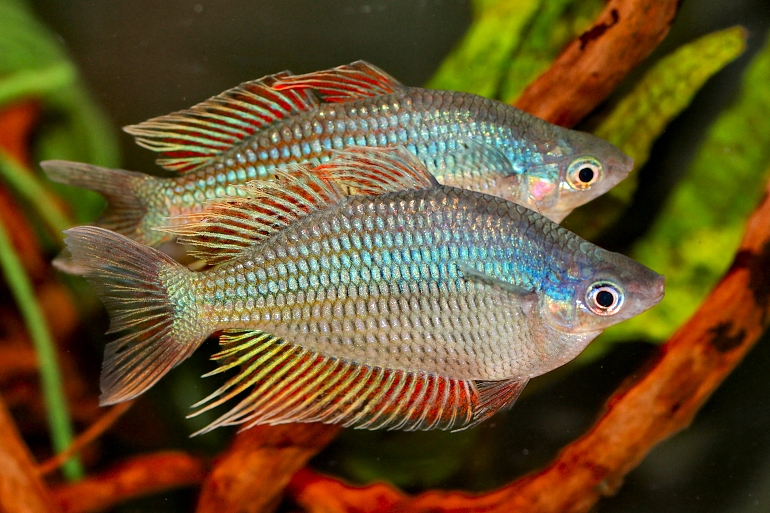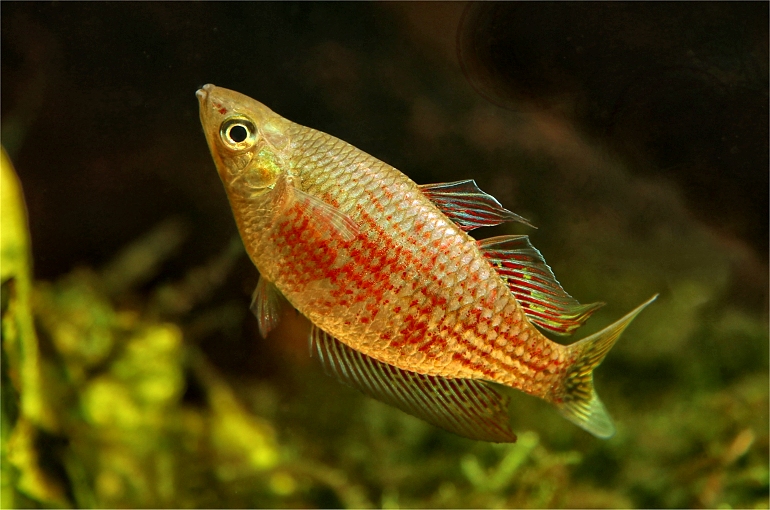|
 |
Melanotaenia rubrostriata (front) M. splendida (back) - photo© Gunther Schmida |
(Ramsay and Ogilby, 1886)
Red-striped Rainbowfish
Species Summary
Melanotaenia rubrostriata have a basic body colouration of overall pale bluish-green, grading to white on the lower sides. Each horizontal scale row is separated by a narrow orange to pink stripe. The membranes between the rays of the second dorsal and anal fin are red. Not easily distinguished from Melanotaenia splendida inornata. Principal differences are body depth, fin counts, and colour pattern, which is variable depending on location and water conditions. Melanotaenia rubrostriata may reach a maximum size (TL) of 16 cm, but usually less than 12 cm, with a body depth of 6-8 cm. Males are more brightly coloured, larger, and much deeper bodied than females.
 |
Melanotaenia rubrostriata [Kavor] - photo© Andreas Wagnitz |
Distribution & Habitat
Melanotaenia rubrostriata were initially collected during the 1880s from the Strickland River, Papua New Guinea. They are widely distributed in southern New Guinea between Etna Bay in West Papua and the Central Province of Papua New Guinea. The Kikori River was the previous eastern limit of distribution, but recent surveys indicate that they are more widespread; having been collected in the Sapoi River in the Lakekamu Basin. The Sapoi River drainage is located approximately 150 km northwest of Port Moresby. They have also been found on the Aru Islands.
Known Locations: Fly River (1975, 2005), Elevala River, Kanggu River, Lake Bosset, Lake Pangua, Strickland River, Lake Murray, Lakekamu River, Sapoi River, Laloki River, Timika, Bensbach River, Etna Bay, Aru Islands, Daru Island, Aramia River, Ok Tedi River, Ok Ma and Kemp Welsh River (1975). In 2005, Melanotaenia rubrostriata were collected at 28 sites in the Fly River catchment - Asaeke Ck, Lake Pangua, Fly River (middle and upper), Binge River, Moian Oxbow (upper Fly River), Elevala River, Palmer River, Ok Tedi (2) and Ok Mart (2)
A recent survey (Hitchcock et al. 2012) found Melanotaenia rubrostriata on Boigu Island and Saibai Island in the Torres Strait. The Torres Strait Islands are part of Queensland and are the only part of Australia sharing a border with another country. Saibai and Boigu are very close to and biologically part of New Guinea. Saibai is a fairly large low-lying mangrove island, 23 km long, only 4 km from the Papua New Guinea mainland. Boigu is Australia's most northerly inhabited island, lying just 6 km from the Papua New Guinea coast. The two nearby islands Aubisi and Monim (together with Boigu called the Talbot Islands) are uninhabited. Like Saibai, the island is swampy with surrounding mangroves. Boigu Island is one of the larger islands of the Torres Strait, being approximately 17 km long and 6 km wide, covering an area of 66.3 km². The island was formed in relatively recent times by deposition of sediment and mud derived from New Guinea rivers onto coral platforms.
Melanotaenia rubrostriata inhabit freshwater creeks and rivers along lowland coastal plains. They are usually found around sub-surface vegetation, submerged logs, or branches. Temperature and pH recorded in their natural habitats range from 24-33°C and 5.6-7.5.
.NA2.jpg) |
Melanotaenia rubrostriata (wild-caught) - photo© Neil Armstrong |
Remarks
Melanotaenia rubrostriata were one of the earlier New Guinea rainbowfishes to be introduced to the aquarium hobby. They first appeared in the Australian hobby around 1959. Live specimens were also collected by Gerald Allen during the period 1978-1982. I obtain my first specimens in 1979 (Kemp Welsh River) and maintained a small population until 1983. This was another rainbowfish that fell out of favour with hobbyists as new species arrived from New Guinea, and much of the captive stock disappeared. However, more recent collections have been undertaken and introduced to the international hobby.
 |
Melanotaenia rubrostriata [Merauke] - photo© Andreas Wagnitz |
Literature
Allen G.R. (1980) A Generic Classification of the Rainbowfishes (Family Melanotaeniidae). Records of the Western Australian Museum 8 (3): 449-490.
Allen G.R. (1991) Field guide to the freshwater fishes of New Guinea. Christensen Research Institute, Madang, Papua New Guinea.
Allen G.R., S.H. Midgley and M. Allen (2002) Field guide to the freshwater fishes of Australia. Western Australian Museum.
Hitchcock G., M.A. Finn, D.W. Burrows and J.W. Johnson (2012) Fishes from fresh and brackish waters of islands in Torres Strait, far north Queensland. Memoirs of the Queensland Museum - Nature 56(1): 13-24. Brisbane.
Perugia A. (1894) Viaggio di Lamberto Loria nella Papuasia orientale. XIII. Pesci d'acqua dolce. Annali del Museo Civico di Storia Naturale di Genova (Serie 2a) v. 14: 546-553.
Ramsay E.P. & J.D. Ogilby (1886) A contribution to the knowledge of the fish-fauna of New Guinea. Proceedings of the Linnean Society of New South Wales (Series 2) Volume 1: 8-20.
Weber M.W.C. & L.F. de Beaufort (1922) The fishes of the Indo-Australian Archipelago. Vol. 4. Heteromi, Solenichthyes, Synentognathi, Percesoces, Labyrinthici, Microcyprini. E. J. Brill, Leiden, xiii+410 pp.
Adrian R. Tappin
Updated July, 2019



|
|

